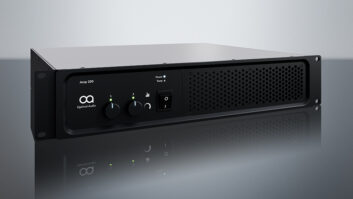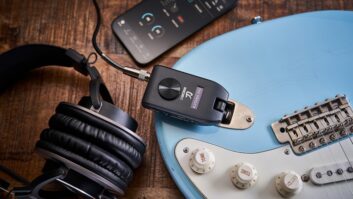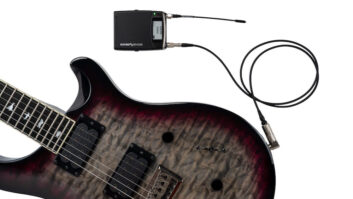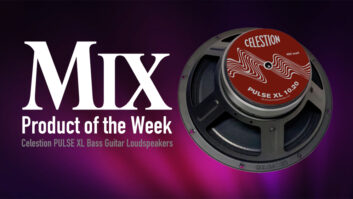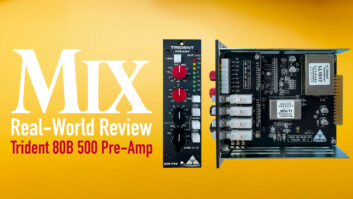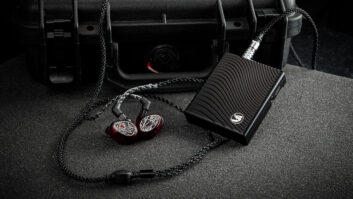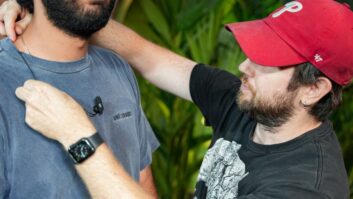There’s nothing quite like the sound of a nasty cool guitar amp or cabinet. The fiery attitude, grit, edge and sometimes extra volume is truly something to behold—and to be heard! But how do you get that huge sound to translate to small speakers, including the ones that go in your ears? Let’s look at a few mic techniques to help make that happen, and we’ll also get some guitar miking tips from Grammy-winning producer/engineer/mixer Neil Dorfsman (Dire Straits, Paul McCartney, Sting, Kiss, Bruce Springsteen, Oasis) and engineer/mixer extraordinaire Richard Chycki (Rush, Dream Theater, Aerosmith).
Don’t Forget The Basics

There’s a reason I’m going to say “start with a Shure SM57.” That’s simply because it works and we’ve all heard it on countless hit records. Stick one of these trusty desert island gems a few inches from the outside cone of a speaker and turn up the preamp. Boom—instant damn good guitar sound.
There are plenty of other mics that can get the job done on their own. For a smoother sound, I’ve used ribbon mics like the Beyerdynamic M 160 and Royer R-121. An AKG C414 large-diaphragm condenser mic covers a lot of ground on its own and features the ability to record multiple polar patterns. For a bigger, thicker sound, the Sennheiser MD-421 II cardioid dynamic mic is one of my favorites, along with a Neumann U 87 (or 67 tube mic if available). Each of these has their own ‘frequency sweet spot,’ so use to taste.
Don’t be afraid to move the mic around the cone area, experimenting with what part of the speaker sounds best, or for that matter, which speaker on the amp sounds best. Also, experiment with the distance of the mic on the speaker. For example, when I’ve recorded guitar great Ace Frehley, he always likes to put the mic right up against the grill of his 4X12 Marshall cabs. This helps deliver a nice thick tone due to the extra bass from the proximity effect of the mic being so close. Ever since, I’ve pretty much done the same thing, maybe moving it back a few inches on occasion, but I’ve found that for the most part, keeping the mic in tight usually delivers the right attitude.
The More Mics, The Merrier
The real fun starts when you introduce several mics (and amps) into the picture. Reaching out to my good friend Neil Dorfsman, he had a few ideas on the topic. “While I’m not necessarily of the opinion that ‘if using one mic is good, using two is better,’ I tend to try and capture multiple representations of electric guitars sounds,” he notes. “For me, there’s so much complex harmonic content that I find one or two mics just don’t do the trick.”
Dorfsman uses a number of setups, but there’s one he turns to the most. “When I mic an electric guitar cabinet, I’ll normally set up two ‘midrange / punchy’ mics—usually a Shure SM57 or Sennheiser MD-421—with one on-axis and one angled about 30 degrees off-axis,” he said. “Then one smooth, less ‘peaky’ mic (usually a ribbon such as a Royer, AEA, RCA 77-DX or Beyer M 160) and one ‘hi-fi’ representation (usually a -20 dB padded AKG C451), and possibly also a ‘full-sounding’ large diaphragm condenser (Neumann U 67, U 47 and so on). In addition, I’ll do a slightly distant ambient pair of large diaphragm condensers, such as U 87s.
How To Choose Your Next Studio Microphone – The Complete Guide
“That is a lot of mics and requires some ‘time and phase alignment’ to make it work,” he continued. “Depending on the sound I’m trying to capture, the diaphragm will be anywhere from 1 to 4 inches away from the cone. The mics are placed in various and different positions, depending on their sonic character and the speaker’s sound. I submix them as I am recording—keeping only the ‘ambient mics’ separate for mixing later. I’ve found it helpful to always also take a DI [from the amp] as well, which can later be re-amped or processed with an amp simulator plug-in while mixing.”
Checking In with Chycki
Richard Chycki takes a variety of approaches, too, when it comes to miking a guitar, ensuring that he has lots of possibilities to work with when it comes time to mix.
“I split the guitar signal, usually with a Radial JD7 for larger setups or a Radial X-Amp 500 for a two-amp split,” he notes. “I always record a guitar DI for both re-amping possibilities and editing, as distorted guitars usually look like an audio sausage [in a DAW, making it] a bit difficult to find transients for editing.”
“For Alex Lifeson from Rush, we set up a string of amps, cabinets and mics and create tone presets on the console as we work,” he said. “The main amp is miked with a Royer R-121, a Mojave Audio MA-301fet and a Shure 57. I don’t EQ the mics individually but use placement and balance between the three mics, submixing to a buss where I have a Pultec EQP-1A EQ and a Urei LA-3A leveling amplifier, and then go to the DAW.
“We do prefer Celestion G12M or Vintage 30 guitar speakers and larger 4×12 cabinets, like Marshall TV or Mesa Boogie Rectifier cabs,” he noted. “For a session as complex as Rush, we had an assortment of other amps connected, including a Mesa Boogie Mark V, a version of a Lerxst Omega [Lifeson’s signature model guitar amp], an Orange OR-120, a 20-watt Hi-Watt, and a Bogner Uberschall. We also used a Roland JC-120 [Jazz Chorus Stereo Combo] processed separately and miked in stereo to capture the full chorus width. All of the amps were miked with combinations of Shure SM57, Royer R-121, Sennheiser MD-409, Shure SM7, Neumann U 47 fet and, of course, the triad of mics mentioned earlier.”
Room ambience is a crucial seasoning for your sound that your mics can provide, depending on your tone and taste. Sometimes you want it, and sometimes you don’t. As Chycki explained, for recording Lifeson, “A pair of Royer R-121s set up using Blumlein Pair technique, and Earthworks SR30s set up X-Y are always on hand for room ambience, if needed. However, for recording John Petrucci’s guitar for Dream Theater, we used the ‘guitar condom.’ The GC is a hut made from bales of Roxul rock wool insulation that encapsulate the guitar cabinet and microphones, completely removing any room sound from the close microphones.”
Capturing big guitar sounds can be as simple as placing a single mic in front of an amp to creating complex setups with DIs and a myriad of sonic options. Take the time to move the mic(s) around, check your phase, check the speaker and experiment. Subtle changes can make a big difference in the final product. Just remember—if it sounds right, it is right, no matter what the setup.
